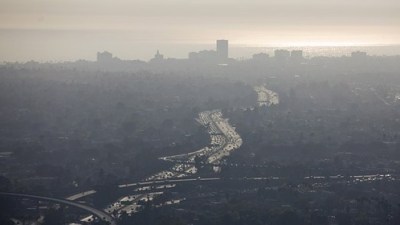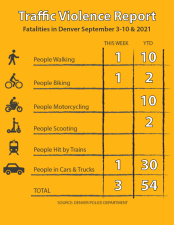North Denver Residents to CDOT: Take a Hike With Your I-70 Widening Plan

The Colorado Department of Transportation and the City and County of Denver have tied so many projects to the repair of an aging I-70 viaduct that residents of Globeville, Elyria, and Swansea have to support adding four lanes to the highway in order to get basic amenities that are commonplace in richer neighborhoods. In order to get parks, safe sidewalks, street lighting, and above all, a viable way to cross the highway that’s divided the neighborhoods since the early 1960s, the community also has to swallow an unnecessary highway widening.
That’s the takeaway from a federally mandated public hearing held by CDOT Wednesday night at Bruce Randolph Middle School, a stone’s throw from the rumbling freeway. Hundreds attended.
The only necessary road project is the repair of an unsafe viaduct. But CDOT, citing outdated traffic predictions, insists on building much more road infrastructure. The agency wants to add four lanes to the highway and sink it below grade in the name of solving congestion. To make it go down easier, CDOT is promising a four-acre “cap” on top that will have parks and other amenities for families and schoolchildren.
“If I offered you a cup full of Drano or a mug full of nails, which one would you pick?” said Cole resident Heidi Sue Harris. “Would you agree that the logical option was missing?”
For most who attended, the logical option is to tear down I-70, re-route it through Commerce City, and turn it into an urban boulevard.
“[CDOT] should check out the situation in I-10 in Houston,” said Swansea resident Jorge Merida. “It’s got 26 lanes, and they built it so that there would be no congestion. Within two months of being built, it was exactly as it was before. These projects of making these highways bigger do not work, do not serve the city.”
More lanes will encourage more driving, pumping more traffic through Denver when the city and state should be focused on transit projects that move people efficiently and cleanly. Eliminating the highway and replacing it with a surface boulevard would reconnect neighborhoods.
Not everyone favors the teardown idea. Cynthia Gallegos is a lifelong resident of the area and a community organizer who says her neighbors want the cap — deserve it — and have for many years. She worked hard to get that option on the table after it was originally discarded, she says.
“I feel like the individuals now talking litigation and that the re-route alternative was the best option from the beginning, they weren’t part of those early discussions,” says Gallegos. “The cap came out of these discussions. When we talked about what an improved community would look like for the residents of Elyria and Swansea and Globeville, the cap allowed residents to see wholeness.”
Indeed, as early as 2012, the cap wasn’t an option. The neighborhoods “would be isolated by a new, wider bridge, one that would eat its way farther into the surrounding neighborhoods,” the Denver Post reported back then. The new plan will displace 56 homes, but the old plan would’ve displaced 124. Gallegos knows this, and though she struggles with it, sees it as a win.
No doubt north Denver deserves the obvious benefits that come with the cap — a nicer and safer place to live, a better local economy, and better access to food in an area where marijuana businesses outnumber quality grocery stores. The question is, why does north Denver have to endure congestion, pollution, and displacement to get those things?
One reason is that the Denver City Council also tied the widening to a critical flood mitigation project, making it even harder to combat. The council committed $83 million in taxpayer dollars to the I-70 boondoggle last year. In exchange, CDOT will contribute money to the drainage project.
“It’s been an issue since the 70s, urban drainage,” said City Councilman Albus Brooks, who voted for the deal. “We built a city over a river. And few cities are in our position to leverage other projects to get the money to do it. I’m supporting the general direction [of the I-70 project], but as you’re hearing tonight from my residents… it’s causing a lot of pause. There’s still a lot of work to be done. I’m conflicted.”
Brooks and Councilwoman Deborah Ortega — who voted against the deal — said Wednesday that they’re looking ahead, trying to soften the blow of a highway expansion with Band-Aids like ensuring air conditioners for residents so construction dust doesn’t sweep through their windows in the summer.
“What I’ve been focused on is not the re-route, but mitigating the impact to these neighborhoods and trying to reduce the footprint of this project,” Ortega said. “I don’t believe we need that many lanes all the way across.”
The Sierra Club is lobbying to get CDOT to formally study the re-route option. “Sierra Club is certainly keeping legal options open on this,” said Bridget Walsh, who lives in Park Hill and spoke on the organization’s behalf Wednesday.
“We are hoping, even though it’s very late in the process, to get CDOT to properly consider the northern re-route option. We oppose this project on grounds of environmental justice, social justice, economic justice, but most importantly on grounds of public health. The impacts on these communities are not acceptable.”


